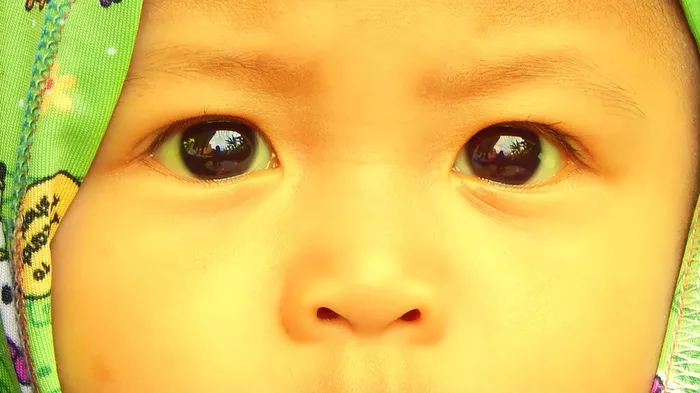Newborn jaundice, a common condition affecting many infants, is characterized by the yellowing of the skin and eyes due to elevated levels of bilirubin in the blood. Bilirubin is a yellow pigment produced when red blood cells break down. In newborns, jaundice often occurs because their livers are still developing and may not process bilirubin as efficiently as in older individuals. This buildup of bilirubin leads to the characteristic yellow hue associated with jaundice.
The causes of newborn jaundice can vary. Physiological jaundice, the most common type, occurs as a normal response to the breakdown of red blood cells after birth. Breastfeeding jaundice may result from insufficient feeding, causing the baby to receive fewer calories and fluids than needed, which can slow down the elimination of bilirubin. Additionally, breastfeeding-associated jaundice can occur when substances in breast milk interfere with bilirubin metabolism. Other less common causes include blood type incompatibility between the mother and baby (such as Rh or ABO incompatibility) or certain genetic conditions affecting bilirubin processing.
Bilirubin Levels
Understanding the normal range of bilirubin levels in newborns is crucial for identifying when levels become elevated and potentially dangerous. Typically, bilirubin levels are measured in milligrams per deciliter (mg/dL). In most newborns, physiological jaundice appears within the first few days of life and peaks around day three to five, with bilirubin levels reaching around 5 to 6 mg/dL. However, these levels are transient and typically do not cause harm.
Bilirubin levels are considered high or dangerous when they exceed certain thresholds. In full-term infants, levels above 20 mg/dL are generally considered very high and require immediate medical attention. Preterm infants may tolerate slightly higher levels, but any rapid increase or levels above 25 mg/dL in preterm babies also warrant urgent evaluation and treatment.
Symptoms of Severe Jaundice
Severe jaundice can manifest with various symptoms that indicate a critical level of bilirubin in the blood. These symptoms may include:
1. Extreme lethargy or difficulty waking the baby
2. High-pitched crying, often different from the baby’s usual cry
3. Poor feeding or reluctance to feed
4. Arching of the body or stiffness
5. Fever or other signs of infection
6. Unusual movements, such as seizures or muscle spasms
These signs suggest that the baby’s body is struggling to cope with the high bilirubin levels and may be at risk of developing complications if not promptly treated.
Treatment Options
When newborn jaundice reaches dangerous levels, medical intervention is necessary. Treatment options depend on the severity of jaundice and the underlying cause. Phototherapy, where the baby is exposed to special lights that help break down bilirubin in the skin, is a common first-line treatment. This can be done using overhead lights or with portable devices that can be used at home under medical supervision.
For more severe cases or when phototherapy is ineffective, other interventions such as exchange transfusions may be required. During an exchange transfusion, small amounts of the baby’s blood containing high bilirubin levels are gradually replaced with donor blood, effectively lowering the bilirubin concentration.
When to Seek Medical Attention
Parents should be vigilant for signs of severe jaundice and seek medical attention promptly if any concerning symptoms arise. Immediate medical evaluation is necessary if:
1. The baby appears excessively lethargic or difficult to wake.
2. There are signs of dehydration, such as decreased urine output or dry mouth.
3. The baby’s skin appears very yellow or the whites of their eyes are noticeably yellow.
4. The baby shows signs of acute distress, such as high-pitched crying or unusual movements.
5. There is a rapid increase in jaundice levels or concerns about feeding adequacy.
Early intervention can prevent complications and ensure the baby receives appropriate treatment.
Prevention and Monitoring
While some cases of newborn jaundice are inevitable, certain strategies can help prevent severe jaundice and monitor bilirubin levels effectively. Adequate feeding, especially in the first few days after birth, is crucial for preventing breastfeeding-related jaundice. Ensuring the baby receives enough fluids and calories helps promote proper bilirubin elimination.
Regular monitoring of bilirubin levels, particularly in high-risk infants or those with known risk factors for severe jaundice, is essential. Pediatricians may recommend blood tests or the use of non-invasive devices that measure bilirubin levels through the skin.
Potential Complications
Untreated or inadequately managed jaundice can lead to serious complications, including a condition called kernicterus. Kernicterus occurs when high levels of bilirubin in the blood cross the blood-brain barrier and accumulate in brain tissues, causing neurological damage. This can result in developmental delays, hearing loss, movement disorders, and cognitive impairment.
While kernicterus is rare due to improved screening and treatment protocols, it underscores the importance of timely intervention for severe jaundice to prevent long-term neurological consequences.
Resources for Parents
Parents of newborns with jaundice may find support and valuable information from various resources:
1. Pediatricians and Healthcare Providers: Consultation with healthcare professionals specializing in newborn care is crucial for accurate diagnosis and treatment guidance.
2. Parenting Support Groups: Online or local support groups for parents of newborns can provide emotional support, shared experiences, and practical tips for managing jaundice.
3. Educational Materials: Reliable sources such as reputable medical websites, books, and pamphlets can offer detailed information on newborn jaundice, treatment options, and preventive measures.
4. National Institutes and Associations: Organizations dedicated to pediatric health, such as the American Academy of Pediatrics (AAP), provide educational materials and guidelines on newborn care, including jaundice management.
By accessing these resources, parents can empower themselves with knowledge and make informed decisions regarding their baby’s health and well-being.
In conclusion, while newborn jaundice is a common and usually benign condition, understanding when it becomes dangerous is crucial for timely intervention and prevention of complications. Monitoring bilirubin levels, recognizing symptoms of severe jaundice, and seeking prompt medical attention are key steps in ensuring optimal outcomes for newborns affected by this condition. With appropriate management and support, most cases of jaundice can be effectively treated, promoting the healthy development of newborns.


